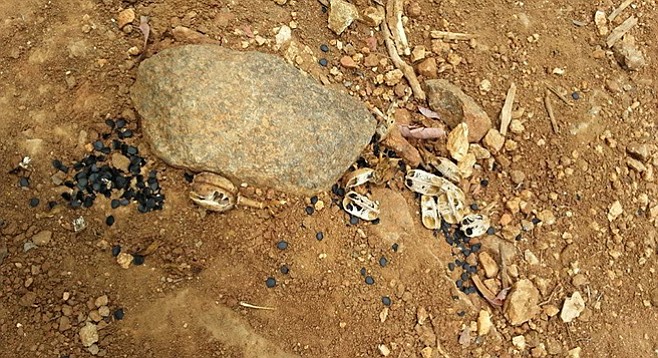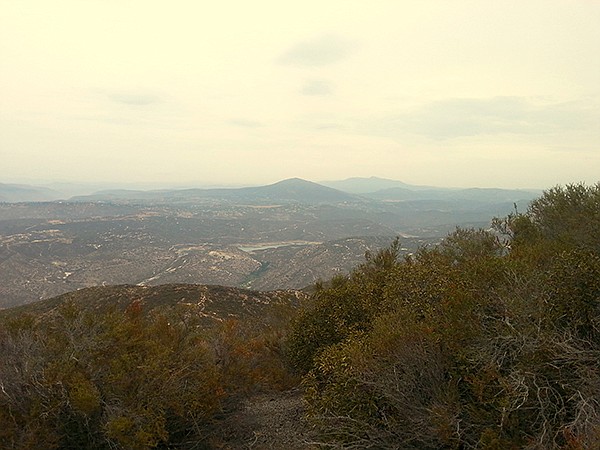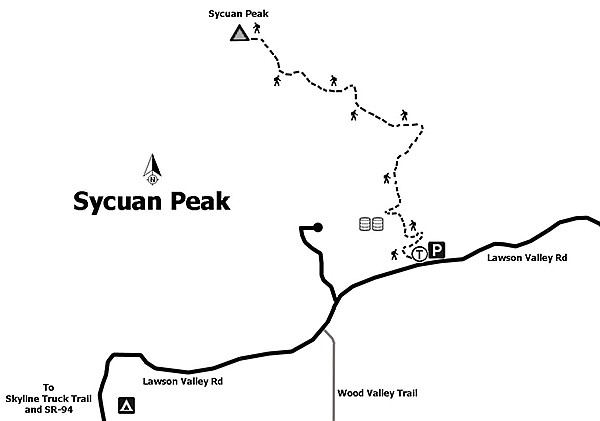 Facebook
Facebook
 X
X
 Instagram
Instagram
 TikTok
TikTok
 Youtube
Youtube


Sycuan Peak at 2801 feet is the high point of the 2300-acre Sycuan Peak Ecological Reserve managed by the California Department of Fish and Wildlife. This area was acquired to protect endangered and sensitive wildlife, special habitats, and native plants. It was designated an ecological reserve in 2000. The area has a unique form of chaparral vegetation that is confined to soils rich in ferromagnesian minerals. It is also a foraging territory for peregrine falcons and other raptors. Sycuan Peak had a designated National Geodetic Survey (NGS) Airway Beacon west of the summit until modern radar and radio communication made ground-based landmarks obsolete for helping pilots navigate U.S. transcontinental flights at night.
The climb to the peak on an old, eroded access road will get your heart pumping quickly. Be sure to wear sturdy hiking shoes and consider a walking stick for the trip down, as there are several steep, slick, gravelly areas where good tread helps. The path is colored a rusty pink in late summer, with California buckwheat and browned chamise tips, which accent the salmon-colored rhyolite. This rock has a similar chemical makeup to stone 180 miles away in Sonora, Mexico, where it is believed to have originated before sliding north due to plate tectonics.

Several towering yucca plants accent the path. Take a look at the six-chambered seed pods littering the path with small, flat black seeds. The yucca has a symbiotic relationship with the female yucca moth, which is the only known pollinator for this plant. She lays her eggs in the plant so that later her young can harvest the seeds. Also prevalent is the smooth, red-barked manzanita named for the small berries (manzanita means “little apple” in Spanish). Coyotes snack on the manzanita berries, the evidence of which is seen in the fruity content of their scat found on the path. Other berries that may be noted earlier in the year include the spiny redberry and spice-bush or bushrue, which has long skinny leaves and orangish-red citrus or dimpled berries, usually gone by late July.
Several fragrant plants perfume the air, including California sagebrush (soft and feathery), white sage (large grayish-green pinwheel leaves used in Native American ceremonies), and laurel sumac (taco shaped leaves that smell like green apples). Scrub oak is also abundant along the path, with a few round, brown or red “oak apples,” which are actually galls formed by the plant as a chemical reaction to the cynipid wasp.

Look up and search for turkey vultures in flight, which have a huge wingspread at 63–72 inches. The smaller red-winged hawk might also be visible. The strange ghostlike caws in the distance likely belong to a peacock from a local farm. This time of year, you might also see a tarantula hawk wasp, whose young larvae hatch inside the paralyzed spider and eat it alive. Dragonflies and June bugs can be present also. The piercing, bouncing birdcall of the wrentit may be heard and is known as the “voice of the chaparral.”
Near the top, the panoramic views begin to unfold, including Loveland Reservoir below. Cliff swallows and white butterflies make their home here. Sit at the boulder on top and enjoy the surrounding hills in solitude. Carefully make your way back down.
Distance from downtown San Diego: 25 miles. Allow 40 minutes driving time (Jamul). From SR-94 E turn left (east) on Lyons Valley Rd. In 1.6 miles, the name of the road changes to Skyline Truck Trail. Continue 2.2 miles, then turn left (north) onto Lawson Valley Rd. and continue for 3.3 miles to the trailhead, which is signed “no vehicles allowed.” Park on the side of the road near the trailhead on the left.
Hiking length: 2 miles out-and-back.
Difficulty: Strenuous. Nearly 800 feet elevation gain/loss in just a mile. No facilities. Dogs (on leashes) allowed.



Sycuan Peak at 2801 feet is the high point of the 2300-acre Sycuan Peak Ecological Reserve managed by the California Department of Fish and Wildlife. This area was acquired to protect endangered and sensitive wildlife, special habitats, and native plants. It was designated an ecological reserve in 2000. The area has a unique form of chaparral vegetation that is confined to soils rich in ferromagnesian minerals. It is also a foraging territory for peregrine falcons and other raptors. Sycuan Peak had a designated National Geodetic Survey (NGS) Airway Beacon west of the summit until modern radar and radio communication made ground-based landmarks obsolete for helping pilots navigate U.S. transcontinental flights at night.
The climb to the peak on an old, eroded access road will get your heart pumping quickly. Be sure to wear sturdy hiking shoes and consider a walking stick for the trip down, as there are several steep, slick, gravelly areas where good tread helps. The path is colored a rusty pink in late summer, with California buckwheat and browned chamise tips, which accent the salmon-colored rhyolite. This rock has a similar chemical makeup to stone 180 miles away in Sonora, Mexico, where it is believed to have originated before sliding north due to plate tectonics.

Several towering yucca plants accent the path. Take a look at the six-chambered seed pods littering the path with small, flat black seeds. The yucca has a symbiotic relationship with the female yucca moth, which is the only known pollinator for this plant. She lays her eggs in the plant so that later her young can harvest the seeds. Also prevalent is the smooth, red-barked manzanita named for the small berries (manzanita means “little apple” in Spanish). Coyotes snack on the manzanita berries, the evidence of which is seen in the fruity content of their scat found on the path. Other berries that may be noted earlier in the year include the spiny redberry and spice-bush or bushrue, which has long skinny leaves and orangish-red citrus or dimpled berries, usually gone by late July.
Several fragrant plants perfume the air, including California sagebrush (soft and feathery), white sage (large grayish-green pinwheel leaves used in Native American ceremonies), and laurel sumac (taco shaped leaves that smell like green apples). Scrub oak is also abundant along the path, with a few round, brown or red “oak apples,” which are actually galls formed by the plant as a chemical reaction to the cynipid wasp.

Look up and search for turkey vultures in flight, which have a huge wingspread at 63–72 inches. The smaller red-winged hawk might also be visible. The strange ghostlike caws in the distance likely belong to a peacock from a local farm. This time of year, you might also see a tarantula hawk wasp, whose young larvae hatch inside the paralyzed spider and eat it alive. Dragonflies and June bugs can be present also. The piercing, bouncing birdcall of the wrentit may be heard and is known as the “voice of the chaparral.”
Near the top, the panoramic views begin to unfold, including Loveland Reservoir below. Cliff swallows and white butterflies make their home here. Sit at the boulder on top and enjoy the surrounding hills in solitude. Carefully make your way back down.
Distance from downtown San Diego: 25 miles. Allow 40 minutes driving time (Jamul). From SR-94 E turn left (east) on Lyons Valley Rd. In 1.6 miles, the name of the road changes to Skyline Truck Trail. Continue 2.2 miles, then turn left (north) onto Lawson Valley Rd. and continue for 3.3 miles to the trailhead, which is signed “no vehicles allowed.” Park on the side of the road near the trailhead on the left.
Hiking length: 2 miles out-and-back.
Difficulty: Strenuous. Nearly 800 feet elevation gain/loss in just a mile. No facilities. Dogs (on leashes) allowed.